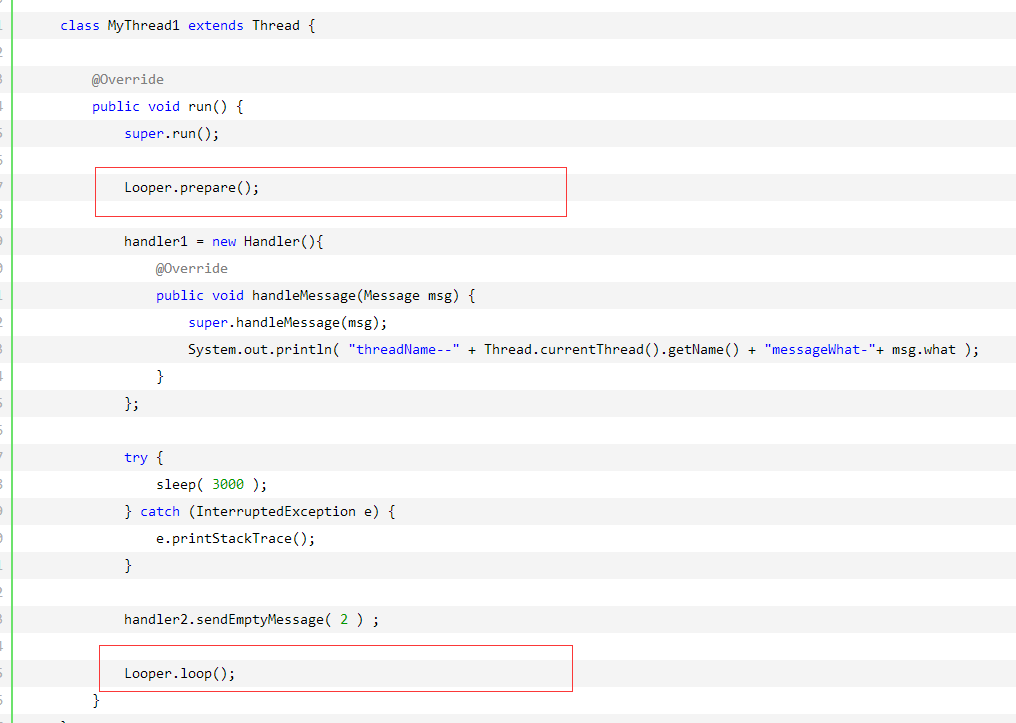转载请标明出处:http://www.cnblogs.com/zhaoyanjun/p/6062880.html
本文出自【赵彦军的博客】
前言
以前我在 【Android Handler、Loop 的简单使用】 介绍了子线程和子线程之间的通信。
很明显的一点就是,我们要在子线程中调用Looper.prepare() 为一个线程开启一个消息循环,默认情况下Android中新诞生的线程是没有开启消息循环的。(主线程除外,主线程系统会自动为其创建Looper对象,开启消息循环。) Looper对象通过MessageQueue来存放消息和事件。一个线程只能有一个Looper,对应一个MessageQueue。 然后通过Looper.loop() 让Looper开始工作,从消息队列里取消息,处理消息。
注意:写在Looper.loop()之后的代码不会被执行,这个函数内部应该是一个循环,当调用mHandler.getLooper().quit()后,loop才会中止,其后的代码才能得以运行。
然而这一切都可以用HandlerThread类来帮我们做这些逻辑操作。
HandlerThread
HandlerThread本质上就是一个普通Thread,只不过内部建立了Looper.
HandlerThread的常规用法
- 创建一个HandlerThread
mThread = new HandlerThread("handler_thread");
启动一个HandlerThread
mThread.start();
退出循环
Looper是通过调用loop方法驱动着消息循环的进行: 从MessageQueue中阻塞式地取出一个消息,然后让Handler处理该消息,周而复始,loop方法是个死循环方法。
那如何终止消息循环呢?我们可以调用Looper的quit方法或quitSafely方法,二者稍有不同。
/*** Quits the looper.* <p>* Causes the {@link #loop} method to terminate without processing any* more messages in the message queue.* </p><p>* Any attempt to post messages to the queue after the looper is asked to quit will fail.* For example, the {@link Handler#sendMessage(Message)} method will return false.* </p><p class="note">* Using this method may be unsafe because some messages may not be delivered* before the looper terminates. Consider using {@link #quitSafely} instead to ensure* that all pending work is completed in an orderly manner.* </p>** @see #quitSafely*/public void quit() {mQueue.quit(false);}/*** Quits the looper safely.* <p>* Causes the {@link #loop} method to terminate as soon as all remaining messages* in the message queue that are already due to be delivered have been handled.* However pending delayed messages with due times in the future will not be* delivered before the loop terminates.* </p><p>* Any attempt to post messages to the queue after the looper is asked to quit will fail.* For example, the {@link Handler#sendMessage(Message)} method will return false.* </p>*/public void quitSafely() {mQueue.quit(true);}相同点:
将不在接受新的事件加入消息队列。
不同点
当我们调用Looper的quit方法时,实际上执行了MessageQueue中的removeAllMessagesLocked方法,该方法的作用是把MessageQueue消息池中所有的消息全部清空,无论是延迟消息(延迟消息是指通过sendMessageDelayed或通过postDelayed等方法发送的需要延迟执行的消息)还是非延迟消息。
当我们调用Looper的quitSafely方法时,实际上执行了MessageQueue中的removeAllFutureMessagesLocked方法,通过名字就可以看出,该方法只会清空MessageQueue消息池中所有的延迟消息,并将消息池中所有的非延迟消息派发出去让Handler去处理,quitSafely相比于quit方法安全之处在于清空消息之前会派发所有的非延迟消息。
无论是调用了quit方法还是quitSafely方法只会,Looper就不再接收新的消息。即在调用了Looper的quit或quitSafely方法之后,消息循环就终结了,这时候再通过Handler调用sendMessage或post等方法发送消息时均返回false,表示消息没有成功放入消息队列MessageQueue中,因为消息队列已经退出了。
需要注意的是Looper的quit方法从API Level 1就存在了,但是Looper的quitSafely方法从API Level 18才添加进来。
小例子:
package com.app;import android.os.Bundle;
import android.os.Handler;
import android.os.HandlerThread;
import android.os.Message;
import android.support.v7.app.AppCompatActivity;
import android.util.Log;public class MainActivity extends AppCompatActivity {private HandlerThread myHandlerThread ;private Handler handler ;@Overrideprotected void onCreate(Bundle savedInstanceState) {super.onCreate(savedInstanceState);setContentView(R.layout.activity_main);//创建一个线程,线程名字:handler-threadmyHandlerThread = new HandlerThread( "handler-thread") ;//开启一个线程myHandlerThread.start();//在这个线程中创建一个handler对象handler = new Handler( myHandlerThread.getLooper() ){@Overridepublic void handleMessage(Message msg) {super.handleMessage(msg);//这个方法是运行在 handler-thread 线程中的 ,可以执行耗时操作Log.d( "handler " , "消息: " + msg.what + " 线程: " + Thread.currentThread().getName() ) ;}};//在主线程给handler发送消息handler.sendEmptyMessage( 1 ) ;new Thread(new Runnable() {@Overridepublic void run() {//在子线程给handler发送数据handler.sendEmptyMessage( 2 ) ;}}).start() ;}@Overrideprotected void onDestroy() {super.onDestroy();//释放资源myHandlerThread.quit() ;}
}运行效果:
/com.app D/handler: 消息: 1 线程: handler-thread
/com.app D/handler: 消息: 2 线程: handler-threadHandlerThread的特点
HandlerThread将loop转到子线程中处理,说白了就是将分担MainLooper的工作量,降低了主线程的压力,使主界面更流畅。
开启一个线程起到多个线程的作用。处理任务是串行执行,按消息发送顺序进行处理。HandlerThread本质是一个线程,在线程内部,代码是串行处理的。
但是由于每一个任务都将以队列的方式逐个被执行到,一旦队列中有某个任务执行时间过长,那么就会导致后续的任务都会被延迟处理。
HandlerThread拥有自己的消息队列,它不会干扰或阻塞UI线程。
对于网络IO操作,HandlerThread并不适合,因为它只有一个线程,还得排队一个一个等着。

![[MathType需要安装新版的MT EXtra字体]解决方法](http://pic.xiahunao.cn/[MathType需要安装新版的MT EXtra字体]解决方法)











)

)



![[C++]MySQL数据库操作实例](http://pic.xiahunao.cn/[C++]MySQL数据库操作实例)
